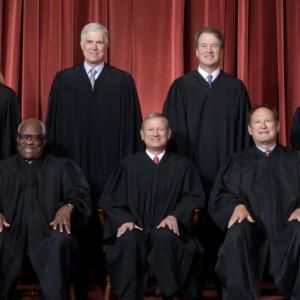Myths are powerful things — so powerful that one has been endorsed by the Supreme Court and now has the federal government by the throat. Its effects will be far-reaching and, at times, disastrous and dangerous. Although a conservative favorite, it will hurt business, in some cases, severely.
The myth is that the government is dominated by “faceless, unelected bureaucrats” with an agenda. According to myth, these bureaucrats are out to frustrate the will of Congress, avoid the courts and ignore their political masters.
In striking down the Chevron deference on June 28 — the actual case was Loper Bright Enterprises v. Raimondo — the Supreme Court sided with critics of the bureaucracy, ending what has been an operational reality for 40 years.
The Chevron deference is a Reagan-area, bipartisan accommodation that recognized that when Congress makes laws in broad strokes and big declarations of intent, the intent often requires refinement of minute scientific detail, like parts per billion of carcinogens allowed in drinking water.
Under the Chevron deference, when Congress had been sloppy, or too general, in its legislation writing, the agencies were empowered to interpret the law and — with public and stakeholder input in the form of hearings and comment periods — make rules.
It is the crux of the administrative state. If those rules were “reasonable,” they couldn’t be litigated; they got “deference.” Although they could be challenged, the implied immunity of deference was mostly honored.
Clinton Vince, who heads the U.S. energy practice at Dentons, the world’s largest law firm, told me that the Supreme Court has upheld Chevron 70 times and has been cited in cases 18,000 times. He spoke on my PBS television program, “White House Chronicle.”
Many of the agency decisions that affect everything from drugs and medical products’ safety to the protection of human health and the environment, to workplace safety, to aviation safety and to the supply of electricity will be made in myriads of court cases.
Vince said that while reasonable people will disagree on the extent of the national disruption, “I believe that there will be an avalanche of litigation by affected stakeholders of different ideologies and that an entirely different paradigm of agency regulation will occur when the courts, rather than the agencies, will be the dominant decision-makers,” he said.
Under Chevron, the federal agencies would write the fine print (promulgate is the term used) that Congress didn’t or was unqualified to define in its legislation.
This fine print, this rendition of what Congress intended, was implemented and seldom challenged in the courts because the understanding embodied in Chevron was that if the rules were reasonable, the courts would stand back.
Conservative argument postulated that this rule-making in areas like the environment, energy, health and labor favored the liberal biases of the permanent bureaucracy.
Charles Bayless, who has been president of two investor-owned electric utilities, in Arizona and Illinois, and of the West Virginia University Institute of Technology, and who has been a party to the Federal Energy Regulatory Commission rule-makings, told me he fears widespread chaos, jammed courts and extensive “forum shopping.”
“Each side will find very liberal and very conservative circuits and find a plaintiff in that jurisdiction. As the judges cannot understand the science, the outcome is likely preordained,” Bayless said.
“Thus, the appeals courts will be jammed with appeals from jurisdictions with biased judges writing opinions where neither they nor the jury understand the science,” he said.
A judge in, say, Wyoming could be asked in one submission to rule on the safety — yes, the safety — of a malaria treatment and in another on the allowable radioactive releases from a nuclear reactor. This is a recipe for confusion and bad law, which will negatively affect business and the public.
As someone who has covered Washington for 50 years, I must say the bureaucracy gets a bad rap. It isn’t monolithic — as the word implies — and is made up of men and women, some of whom (as in any other large group) may be biased and unfit for what they do.
But it also has a vast number of hardworking, ordinary Americans. This is particularly so in agencies like the Food and Drug Administration and the Federal Energy Regulatory Commission, which administer technologically and scientifically based law. I call them the “hard” agencies because they rely on scientific and engineering expertise in their operation.
It is pure myth that they constitute a swamp or have pre-set agendas. Oh, and they do have faces.









